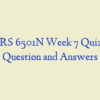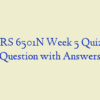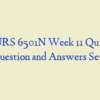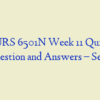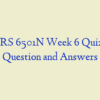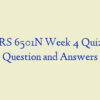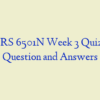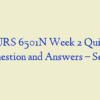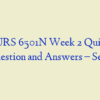Description
NURS 6501N Week 5 Quiz with Answers (30 out of 30)
- A 20-year-old female is being admitted to the hospital with fever and septic shock. Which set of assessment findings would the nurse expect the patient to exhibit?
- A newborn is diagnosed with congenital heart disease. Which of the following intrauterine factors should the nurse focus on during the history that could have caused this disorder?
- A 1-month-old infant was diagnosed with truncus arteriosus (TA) with a ventricular septal defect. Which of the following would the nurse also expect?
- A newborn experiences frequent periods of cyanosis, usually occurring during crying or after feeding. Which of the following is the most likely diagnosis the nurse will observe on the chart?
- An 8-week-old infant presents to her primary care provider for a well-baby check. Physical exam reveals a murmur, and an echocardiogram shows a large ventricular septal defect. If left untreated, what condition should the nurse discuss with the parents?
- A 42-year-old female is diagnosed with constrictive pericarditis. The nurse assesses the blood pressure for decreased cardiac output because of:
- A newborn child is diagnosed with tetralogy of Fallot. What symptoms would the nurse expect to observe in the child?
- A 15-year-old male who is allergic to peanuts eats a peanut butter cup. He then goes into anaphylactic shock. Which assessment findings will the nurse assess for?
- A 3-year-old male is diagnosed with Kawasaki disease. Which of the following does the nurse suspect is the most likely cause?
- What factors make a patient prone to neurogenic shock? Neurogenic shock can be caused by any factor that inhibits the: nurs 6501n week 5
- A 10-year-old male presents with fever, lymphadenopathy, arthralgia, and nose bleeds. He is diagnosed with rheumatic heart disease. While planning care, which characteristic changes should the nurse remember?
- A 72-year-old female has a history of right heart failure caused by a right ventricular myocardial infarction. Which of the following symptoms are specifically related to her right heart failure?
- A newborn is suspected of having coarctation of the aorta. Which of the following assessments would aid in diagnosis?
- A 67-year-old female was previously diagnosed with rheumatic heart disease. Tests reveal lipoprotein deposition with chronic inflammation that impairs blood flow from the left ventricle into the aorta. Which of the following is the most likely diagnosis recorded on the chart?
- A 51-year-old male presents with recurrent chest pain on exertion. He is diagnosed with angina pectoris. When he asks what causes the pain, how should the nurse respond? The pain occurs when:
- One consequence of switching from aerobic to anaerobic cellular metabolism during shock states is: nurs 6501n week 5
- An infant undergoes an echocardiogram for a suspected heart defect. Tests reveal an opening in the middle of the atrial septum. What term would the nurse use to describe this defect?
- Upon assessment of the patient, the nurse finds a widened pulse pressure and throbbing peripheral pulses. Which valve disorder does the nurse suspect?
- A newborn baby is severely cyanotic. An echocardiogram reveals transposition of the great arteries. A nurse assesses for which of the following, as it usually occurs with this defect?
- A 60-year-old female was diagnosed with mitral stenosis. As a result, the nurse realizes the patient has incomplete emptying of the:
- A nurse is planning care for a patient in shock. Which principle should the nurse remember? During shock states, glucose uptake is usually:
- For an infection to progress to septic shock, which of the following factors should the nurse determine occurred?
- A 75-year-old male has severe chest pain and dials 911. Lab tests at the hospital reveal elevated levels of cardiac troponins I and T. Based upon the lab findings, the nurse suspects which of the following has occurred?
- A 50-year-old male was admitted to the intensive care unit with a diagnosis of acute myocardial infarction (MI). He is being treated for shock. His cardiopulmonary symptoms include low blood pressure, tachycardia, and tachypnea. His skin is pale and cool. The primary cause of his shock is most likely:
- A nurse recalls the most common cardiac valve disease in the United States, which tends to be most prevalent in young women, is:
- When a patient with left heart failure starts to have a cough and dyspnea, which principle should the nurse remember? Pulmonary symptoms, common to left heart failure, are a result of:
- A 20-year-old male underwent an echocardiogram to assess chest pain. Results revealed a congenital defect in papillary muscles. Which of the following would the nurse expect to occur?
- A 49-year-old male presents to his primary care provider reporting chest pain. EKG reveals ST elevation. He is diagnosed with myocardial ischemia. Which of the following interventions would be most beneficial?
- A 22-year-old pregnant female presents for a fetal echocardiogram. Tests reveal small left atrium and mitral valve and an absent left ventricle and aortic valve. The diagnosis is hypoplastic left heart syndrome (HLHS). The nurse will anticipate that the treatment for this defect is: nurs 6501n week 5
- A 72-year-old female has a history of hypertension and atherosclerosis. An echocardiogram reveals backflow of blood into the left ventricle. Which of the following is the most likely diagnosis documented on the chart?



